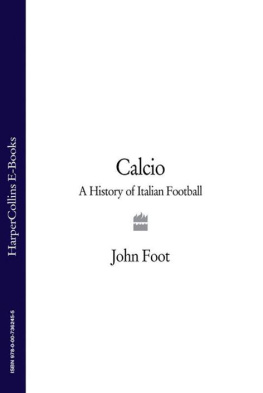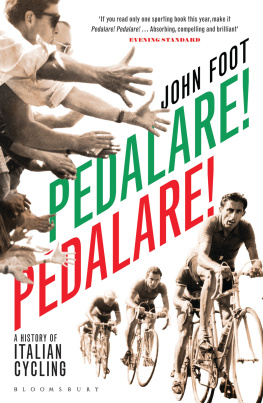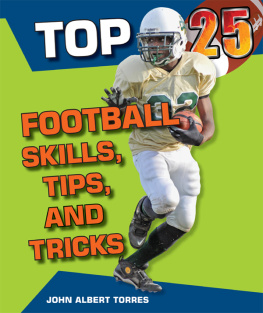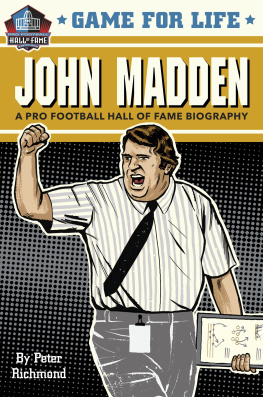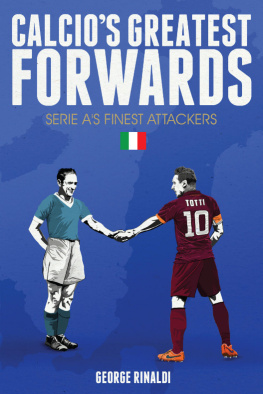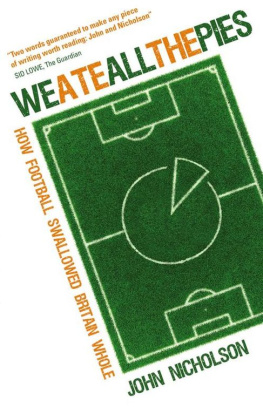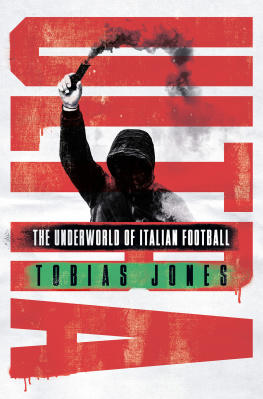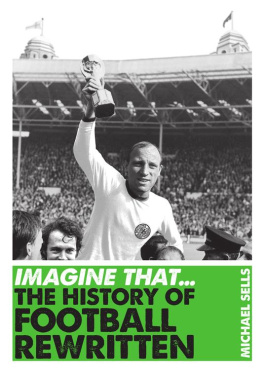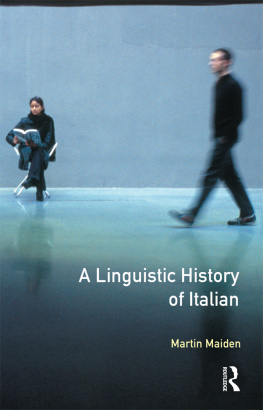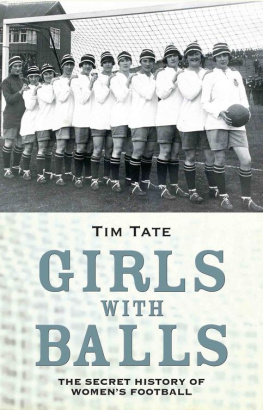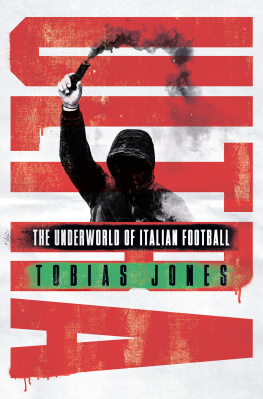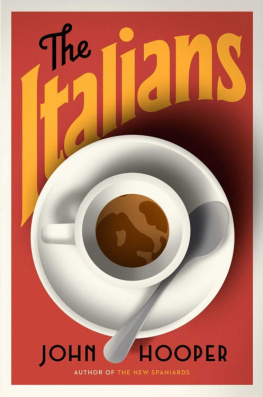John Foot - Calcio: A History of Italian Football
Here you can read online John Foot - Calcio: A History of Italian Football full text of the book (entire story) in english for free. Download pdf and epub, get meaning, cover and reviews about this ebook. year: 2007, publisher: Harper Perennial, genre: Science. Description of the work, (preface) as well as reviews are available. Best literature library LitArk.com created for fans of good reading and offers a wide selection of genres:
Romance novel
Science fiction
Adventure
Detective
Science
History
Home and family
Prose
Art
Politics
Computer
Non-fiction
Religion
Business
Children
Humor
Choose a favorite category and find really read worthwhile books. Enjoy immersion in the world of imagination, feel the emotions of the characters or learn something new for yourself, make an fascinating discovery.
Calcio: A History of Italian Football: summary, description and annotation
We offer to read an annotation, description, summary or preface (depends on what the author of the book "Calcio: A History of Italian Football" wrote himself). If you haven't found the necessary information about the book — write in the comments, we will try to find it.
Calcio: A History of Italian Football — read online for free the complete book (whole text) full work
Below is the text of the book, divided by pages. System saving the place of the last page read, allows you to conveniently read the book "Calcio: A History of Italian Football" online for free, without having to search again every time where you left off. Put a bookmark, and you can go to the page where you finished reading at any time.
Font size:
Interval:
Bookmark:
A History of Italian Football

For my dad, who loved football ,
and my son, who hates it
Readers are advised to consult the glossary at the end of the book.
Football is always late in making history
GIOVANNI ARPINO and ALFIO CARUSO
Ive never really forgiven Italian football, or Juventus, for buying my favourite player in 1980. Liam Brady was my hero and a footballing genius and I saw him from the North Bank as he scored against Manchester United in 1978. Later, I watched with awe as he destroyed Tottenham at White Hart Lane with one of the greatest goals ever seen on UK TV. Bradys last act for Arsenal was to miss a penalty in the ill-fated shoot-out that decided the Cup Winners Cup final with Valencia in 1980. I followed Bradys career in Italy religiously, waiting for signs that the prodigal son would return home. After two championships in two seasons with Juventus (the second of which was decided by Bradys ice-cool penalty on the last day) Liam was sacked in favour of Michel Platini. Surely, now, he would return to Highbury. But Italian football continued to employ him for another five years: at Sampdoria, Inter and finally even Ascoli. When Brady eventually came back to England he was a shadow of the player he had been, managing one more season with West Ham (where he scored a beautiful goal against Arsenal) before retiring and finally coming back to Highbury as youth coach.
Italian football, then, stole my hero. Later, this interest in calcio (the Italian word for football) began to blossom when I moved to Milan in 1988 ostensibly to study the origins of fascism in that ex-industrial city. My Italian was picked up largely through watching TV, and trying to follow the innumerable matches screened at that time. I started to buy the pink Italian sports daily La Gazzetta dello Sport. My first vocabulary was football-linked: calcio di rigore penalty; penalty also penalty; rimessa laterale throw in; calcio di punizione free kick; ammonizione booking; calcio dangolo corner; corner also corner; il mister the manager. Many of the terms seemed to be simply English words, although sometimes they had slightly different meanings. Other phrases were more difficult gamba tesa going into a tackle with your leg straight out; espulsione sending off; melina passing the ball around uselessly amongst the back four. I started to take the tram to one of the most stunning football stadiums in the world the San Siro at that time being refurbished for the upcoming 1990 World Cup.
In my first year in Milan, Inter easily won the championship under record-breaking manager Giovanni Trapattoni. I had found my team. Surely, they would go on to success after success. Moreover, they were the club supported by my future Milanese wife (and, perhaps even more crucially, my future mother-in-law). The good omen of Arsenals last-gasp championship victory in the same season sealed my decision: it was the wrong one. Inter would not win another championship for 17 years, and even then in the most bizarre circumstances imaginable. In the early 1990s, however, AC Milan were the team to watch. Under the innovative tactical regime of manager Arrigo Sacchi, the citys other team played the most scintillating form of attacking football imaginable. Catenaccio (a defensive style of football, made popular in Italy) was rejected in favour of a fast-moving, aggressive game. Plus, Milan had the players to match this style of play. A Dutch trio dominated the early 1990s dreadlocked Ruud Gullit (who flew back on the same plane as me to London on one occasion, and was followed around town by huge crowds of fans) provided pace, flair and explosive attacking skills. Frank Rijkaard was the midfield general (I also bumped into him at the airport Milan is a small city) whilst up front prowled the most complete striker of his generation Marco Van Basten. All this was supported from the back by two of the greatest defenders in football history Franco Baresi and Paolo Maldini. Teams still played with sweepers when I arrived but Milans success was to herald the death of that tradition. This was football from heaven. I also noticed that the teams president was a short, balding, charismatic businessman who smiled a lot and interfered with great frequency in his teams affairs. I was to see a lot more of this man through the 1990s. I even ended up studying him. His name? Silvio Berlusconi.
In 1989 AC Milan reached the European Cup final for the first time in twenty years, and they destroyed Steaua Bucharest (40). I watched the game on the colour TV in my room. Foolishly, I decided to get a bus across town after the match. The bus arrived, and then stopped after about 100 yards amidst a mass of delirious fans. The driver finally gave up all hope when people began climbing on the roof. The celebrations went on for days. In 1990, Milan won the European Cup again and on the way to the final they took apart Real Madrid 50 with a stunning display of authority, skill and power. There was no doubt that Milan were the greatest team in the world at that time, and Van Basten and Gullit dominated the European Footballer of the Year award throughout the early 1990s.
At San Siro, the atmosphere was electric, and vastly different to my experiences following Arsenal and Plymouth Argyle in England. Orchestrated singing was organized by head fans with megaphones, who spent their time watching their fellow fans, and not the game. Fireworks and flares greeted the arrival of the teams. From San Siros towering terraces, you could see the whole pitch as if it were a chessboard. In anger, Italian fans did not just boo, or whistle: they went crazy. Cushions and more dangerous missiles were routinely hurled onto the pitch. Violence was common, just as the shock of Hillsborough was finally cleaning up the English game. I noticed with pleasure that there were very few racist chants at Italian matches. This was soon to change, and for the worse.
And then there were the rivalries not so much the local Milan derby but regional differences appeared to provide the opportunity for violence and conflict. Naples and their star player Maradona were particular hate-figures in the north. During the opening match of the 1990 World Cup, Maradona was booed by the huge crowd during Argentinas warm-up in the San Siro. Cameroon were the choice for the Italians and they duly won, 10. Maradona was to get his revenge in spectacular fashion in his adopted Naples, three weeks later, as his penalty knocked the hosts out of the tournament. Milan and Roma also had a long-running rivalry going. At an Italian cup semi-final, attended by 80,000 passionate fans in the San Siro, the tension was palpable. When Milan missed a last-minute penalty and lost, fights broke out. I left the stadium and walked towards the station. Suddenly, a stone flew past my head. I looked up; in front of me stood a line of riot police, complete with helmets, batons and, in some cases, guns. Behind me, I noticed a number of youths (Milan fans, not happy with the result) with handkerchiefs covering their faces. They were hurling rocks and sticks. What to do? Go back towards the fans, or forwards towards the police line? I decided on the latter option. For a second, the line parted to let me through, and then closed again. This whole semi-riot, which lasted some hours, was barely reported in the Italian press.
Media coverage of football was total, and impossible to ignore. Goals were analysed way into the night, from every possible angle, but so were offside decisions, and even lip-read words. This was normal. Referees were lambasted for errors of judgement, and routinely accused of corruption and favouritism. Players were lambasted for one bad performance, managers sacked after a couple of bad results, teams said to be in crisis, officially after a couple of draws. Whole programmes consisted entirely of men shouting at each other about football, for hours. One such programme Il processo del luned (Mondays Trial) had been running since 1980. Local TV stations were also dominated by such low-budget programmes, concentrating largely on the Milan teams in my area, whose every game, training session and transfer was picked over in minute detail. I began to have conversations about football, quickly realizing that English football was simply not taken seriously in Italy. For Italians, English teams still played the long ball game, and the back four consisted of lanky defenders who would never get a game in Italy. When people asked me whom I supported and I told them, many replied, irritatingly, Aston Villa? When I tried to explain who Arsenal were, I used Brady but very few had heard of my club.
Font size:
Interval:
Bookmark:
Similar books «Calcio: A History of Italian Football»
Look at similar books to Calcio: A History of Italian Football. We have selected literature similar in name and meaning in the hope of providing readers with more options to find new, interesting, not yet read works.
Discussion, reviews of the book Calcio: A History of Italian Football and just readers' own opinions. Leave your comments, write what you think about the work, its meaning or the main characters. Specify what exactly you liked and what you didn't like, and why you think so.

